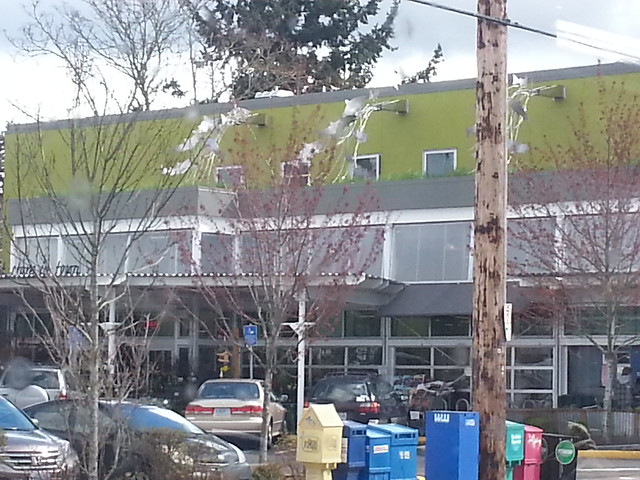Next up we're visiting downtown Portland's "South Terminus", the little park/plaza at the south end of the downtown transit mall, where the MAX Green Line turns around and the Yellow Line becomes the Orange Line (and vice versa). The most notable feature of the place, from a distance, is a tall curved steel structure seen in most of the photos above, which exists to hide (and keep people out of) an electrical substation. The inner workings of it are further concealed by a fence and something called "coil drapery", and (most importantly) the south-facing side of the structure is covered in solar panels, which contribute a purely symbolic amount of electricity toward running the train.
North of all that, there's the actual turnaround area, which takes up most of the block and is just utilitarian train tracks and gravel. And because MAX trains have the turning radius of, well, trains, there was a crescent of land left over inside the loop, which became a small brick plaza and landscaped garden.
All of this was originally built in 2009 for the Green Line, and then "completed" in 2012, and reworked a bit in 2015 for the Orange Line, and further redesigned in 2017 for reasons we'll get to in a moment. If you're familiar with my ongoing projects and occasional obsessions here, you'd think I would have had a post up about it the day it opened, but no. I didn't even pay very close attention as it changed repeatedly over time.
The original design firm behind the project still has a project page up bragging about it, and -- to be fair -- the project got all sorts of rave reviews when the Green Line opened, like a 2009 Architect's Newspaper article, a breathless Oregonian article from January 2010, a similar Avada article, and a 2010 issue of FORM magazine. Though I should note that all of this publicity came even though the solar energy part of the project wouldn't be ready for another two years.
One of the selling points behind their design was, we're told, that "the solar panels identify both Portland and TriMet as leaders in sustainability". Solar project finally opened in 2012 and proved to be a bit controversial. Different articles tell us it either produces around 65,000 kilowatt-hours per year, or 67,000 kilowatts per year, depending on who's reporting and how much they know about electricity. Which is not a lot of power given what they paid for the system (although it cost less than half the original projections thanks to price drops for solar gear). Projections at the time were that the system would pay for itself in about 65 years, though a TriMet spokesman insisted it would be more like 22.5 years, which would mean it's over halfway paid for at this point, which is nice, I guess.
The original plan here was a bit more ambitious and would have augmented the trickle of solar power with a trickle of wind power from 22 little fun-sized wind turbines atop the power poles. Unfortunately(?) the startup that was chosen to build these Little Windmills That Could couldn't get the job done and the whole firm cratered shortly afterward. At that point the idea was quietly dropped.
At one point there was a bench somewhere in the park/plaza area with a builtin LED display so visitors could monitor the system's power output as electricity dribbled out of it. I vaguely remember seeing it, but it's not there now. I can only guess at the timeline but I imagine it was damaged beyond repair by bored vandals shortly after it went in, and then quietly removed during the next renovation, since that's what always happens around here. Or at least it's what always happens in public spaces when you don't give "normies" any reason to spend time there.
I do have a proposal here: At whatever point they redesign the park again, my suggestion would be to divert some of the plaza's solar bounty to power a wireless charging station. To me, charging your phone from those solar panels right over there makes for a much better demonstration than just watching LED numbers tick over in electrical units almost nobody really has a feel for. You might ask why, if that's really such a great idea, why didn't they build it that way in the first place? That's actually an easy one: The project was designed prior to 2009, and wireless charging was still a wacky sci-fi idea back then, shelved next to flying cars and atomic jetpacks. By early 2012 the technology had advanced from "works in the lab" to "getting hyped at CES", but a lot of ideas get hyped at trade shows but never ship in volume, much less catch on with the public. The first phones supporting the new Qi power standard finally shipped in September of that year.
There was also an online version of that power meter, so you could watch your tax dollars at work without getting off your couch, if you were so inclined. The site continued on for years, long after its brick-and-mortar version was hauled away. But it's gone now, because if you were designing a hip, fancy, cutting-edge website in 2009-2012, chances are you built it in Adobe Flash, the powerful full-featured programming language of the future. Over time that consensus shifted to "Flash is insecure and unfixable", and it was officially discontinued in all major browsers on New Years Eve 2021, thus breaking the site. Maybe somebody who cares enough will go back fix it at some point, but I wouldn't bet money on that. Old websites that survive in the long term usually do so by being very low maintenance, like the Space Jam and Mars Pathfinder sites, both from 1996.
All in all, the solar thing was exactly the sort of project Republicans have in mind when they sneer at people for "virtue signaling". But that's a bit unfair in this case; the idea is not to radiate civic virtue directly, but to persuade rich Californians to invest in luxury real estate here, thus boosting the local tax base and (in theory) paying for future civic virtue that way.
There was also a small piece of land left over that they couldn't use for turning around, as it was inside the minimum turning radius of any MAX car, so it became sort of a public mini-garden. also I could swear there used to be public access into the landscaped area. A page at Kavanagh Transit Photos confirms my memory of this, showing what the place looked like in 2009 when it was new. No fence around the place then.
We get a hint of the issues facing the park in a September 2013 nuisance complaint, which asserted the plaza was full of tall grass and weeds and animal feces at that point, which seems accurate if memory serves.
Like a lot of people who take up gardening as a hobby, after a few years of it TriMet evidently realized it couldn't keep up with the watering and weeding and in 2017 hired another landscaping firm to rework the design into something a bit more low-maintenance. Their page says, diplomatically, that nearby construction killed a lot of the original plants here. The page says something about designing a fence to keep people out during construction, maybe it became permanent at that point. The signs around the area say "Limited Access" rather than the usual "No Trespassing" or "No Public Access". I'm not really sure what "Limited Access" means here. It's an unfamiliar bit of officialese and I'm not sure how to interpret it. Maybe it's still officially open and there just aren't any entrances anymore. Maybe you're only allowed in on group tours, which are offered once every other decade.
Oh, and before all of this, there was a circa-1900 house here. It wasn't on the National Register of Historic Places, but was on the city's historic inventory as of 2002 (mentioned in some of the paperwork around moving the Simon Benson House, a National Register property) A little searching came back with a photo of that house, from an interesting Rose City Transit page about what various MAX stations looked like before they were MAX stations.

